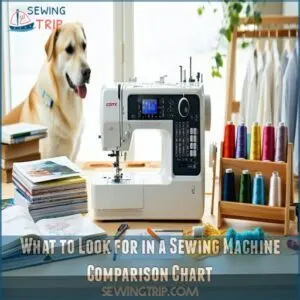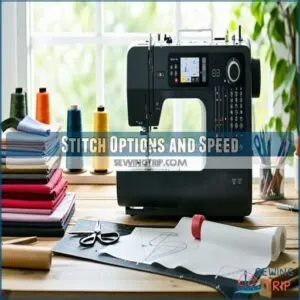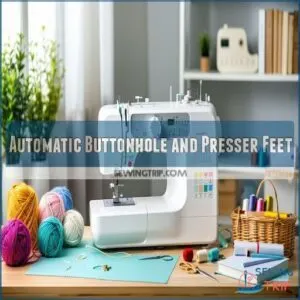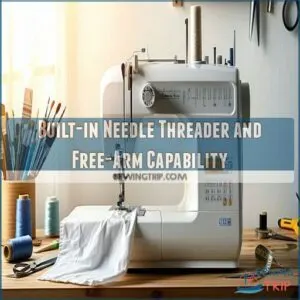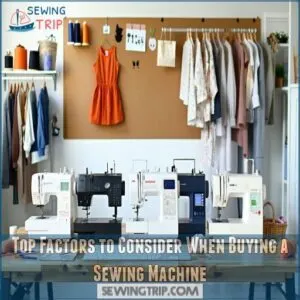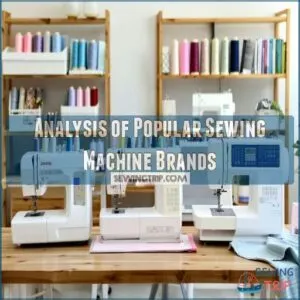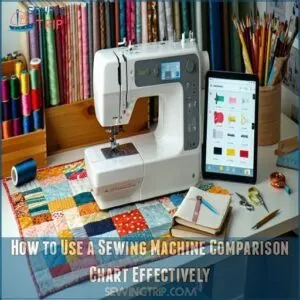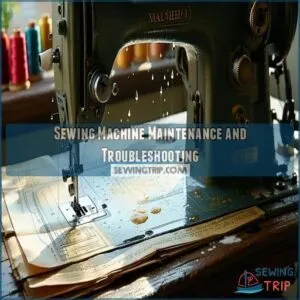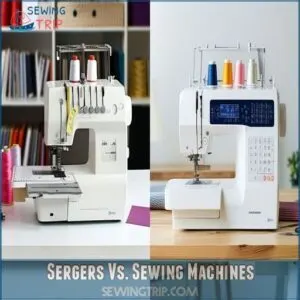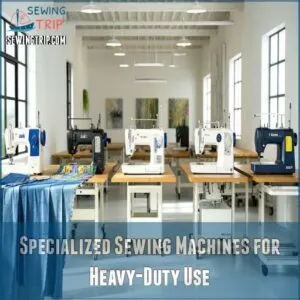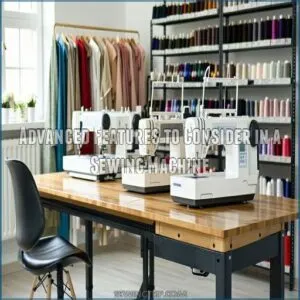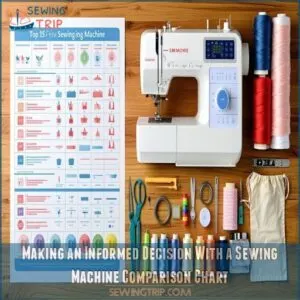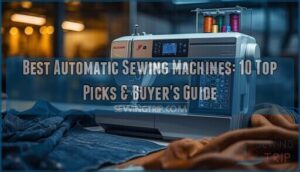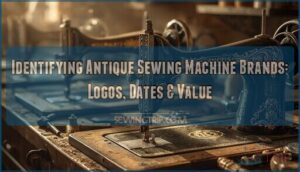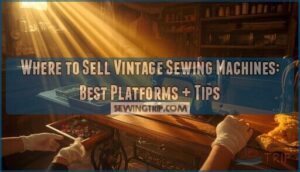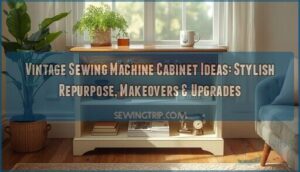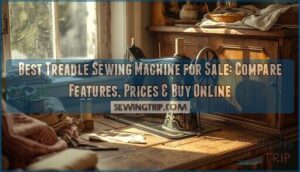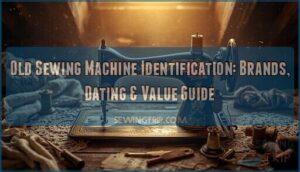This site is supported by our readers. We may earn a commission, at no cost to you, if you purchase through links.
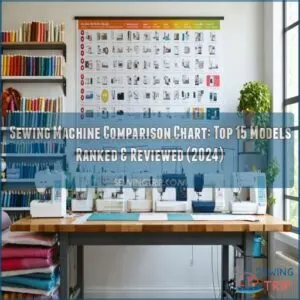
It simplifies the overwhelming world of stitching by breaking down essential details—like stitch options, sewing speed, and automatic features—into an easy-to-scan format.
Whether you’re a beginner tackling basic repairs or a pro mastering thick fabrics, these charts help you pinpoint what suits your skill level and budget.
Compare mechanical versus computerized models, explore handy touches like automatic threading, or check motor strength for heavy-duty jobs.
Nail this choice, and you’ll be stitching stress-free. Ready to find your dream machine? The details are waiting!
Table Of Contents
- Key Takeaways
- Choosing The Right Sewing Machine
- What to Look for in a Sewing Machine Comparison Chart
- Key Features to Compare in Sewing Machines
- Top Factors to Consider When Buying a Sewing Machine
- Analysis of Popular Sewing Machine Brands
- How to Use a Sewing Machine Comparison Chart Effectively
- Sewing Machine Maintenance and Troubleshooting
- Types of Sewing Machines for Different Needs
- Advanced Features to Consider in a Sewing Machine
- Making an Informed Decision With a Sewing Machine Comparison Chart
- Frequently Asked Questions (FAQs)
- Conclusion
Key Takeaways
- You’ll need to consider durability and build quality first – machines with metal frames and components last longer than plastic ones, though they’ll cost more upfront.
- Your skill level and budget should guide your choice – entry-level machines ($150-300) are perfect for basics, while mid-range models ($300-800) offer room to grow your skills.
- You can’t go wrong focusing on essential features like stitch options, sewing speed, and automatic threading – these impact your daily sewing experience more than fancy extras you might never use.
- You’ll get the most value by using comparison charts to evaluate technical specs, user reviews, and warranty coverage side by side – this helps you spot the best match for your specific needs.
Choosing The Right Sewing Machine
You’ll find the perfect sewing machine when you match your skill level, budget, and project needs with the right features and capabilities.
Whether you’re a beginner looking for a basic mechanical model or an experienced sewist seeking advanced computerized features, our comparison chart breaks down the essential specs of today’s top machines.
Factors to Consider
Choosing your perfect sewing companion isn’t just about the price tag – it’s about finding a match for your sewing journey.
When comparing machines, you’ll want to weigh several important factors that impact your experience.
- Machine Durability: Consider metal vs. plastic frame construction
- Sewing Speed: Check stitches per minute for efficiency
- Fabric Types: Verify compatibility with your preferred materials
- User Experience: Look for intuitive controls and clear instructions
- Sewing Costs: Factor in maintenance, accessories, and warranties
Sewing Machine Types
You’ll find four main sewing machine types, each designed for specific needs.
Let’s break them down with a quick comparison:
| Type | Best For |
|---|---|
| Mechanical Machines | Basic home projects, beginners |
| Computerized Models | Precision work, advanced stitching |
| Heavy Duty | Thick fabrics, frequent use |
| Overlock Machines | Professional seam finishing |
Think of these types as your crafting toolkit – from straightforward mechanical machines for simple repairs to sophisticated computerized models that’ll handle your most creative projects.
Skill Level and Budget
Three essential factors determine your perfect sewing match: your current abilities, future sewing goals, and available budget. Let’s make your investment count by finding that sweet spot between skill level and spending power.
- Entry-level machines ($150-300) pack essential features for basic projects
- Mid-range models ($300-800) offer growing room for developing skills
- Professional units ($800-2000) deliver advanced capabilities for serious crafters
- Premium computerized machines ($2000+) suit experienced sewists
- Industrial-grade options ($3000+) cater to commercial needs
Remember, the key isn’t spending the most—it’s matching your current skill level with a machine that’ll grow alongside your sewing journey.
What to Look for in a Sewing Machine Comparison Chart
Every good sewing machine comparison chart should make your decision crystal clear. When you’re scanning those product comparison tables, focus on these key elements that’ll help you spot the perfect match. Understanding the sewing machine differences is essential for an informed purchase.
| Chart Feature | What to Look For |
|---|---|
| Price Range | Budget to premium brackets clearly listed |
| Spec Clarity | Technical details explained in plain English |
| User Ratings | Real feedback from verified buyers |
| Model Details | Current year models vs discontinued |
| Performance | Actual stitch quality and speed metrics |
Don’t get caught up in the marketing fluff – a reliable sewing machine comparison chart should give you the straight facts. Look for detailed breakdowns of included accessories, warranty coverage, and dealer support. Those seemingly tiny details often make the biggest difference when you’re ready to start your next project.
Remember, the best charts let you filter and sort by what matters most to you.
Key Features to Compare in Sewing Machines
You’ll find it easier to pick the perfect sewing machine when you know which features matter most, from stitch options and speed control to buttonhole styles and presser feet.
Whether you’re creating your first project or tackling complex quilts, understanding these key features will help you compare models and find the best match for your sewing needs.
Stitch Options and Speed
Now that you’ve got your comparison chart in hand, let’s talk about what really makes a machine tick.
Your stitch variety and speed control can make or break your sewing experience.
While basic machines nail the straight and zigzag stitches perfectly fine, you’ll see fancier models boasting impressive stitch counts.
Understanding the different sewing machine stitches is essential for selecting the right machine for your needs.
Remember, higher stitches per minute (SPM) means faster sewing, but what matters most is finding a speed that matches your comfort level.
Automatic Buttonhole and Presser Feet
Behind great buttonholes and perfect seams lies the magic of presser feet and automatic buttonholing. Your sewing machine’s presser foot types determine what you can create, while buttonhole styles add that professional finish.
- One-step buttonholes save time over four-step options
- The walking foot prevents fabric layers from shifting
- Zipper feet create clean, precise zipper installations
- Blind hem feet produce invisible hems effortlessly
- Quarter-inch feet guarantee consistent seam allowances
These features transform basic machines into versatile powerhouses that’ll tackle any project you throw at them.
Built-in Needle Threader and Free-Arm Capability
While automatic buttonholes let you focus on creativity, a built-in needle threader and free-arm capability take your sewing efficiency to new heights.
You’ll save time and reduce eye strain with automatic threading, while the free arm lets you tackle tricky spots like cuffs and collars with ease.
| Feature | Benefit |
|---|---|
| Thread Cutter | Quick project completion |
| Arm Length | Better fabric control |
| Needle Control | Precise stitch placement |
| Machine Portability | Easy storage and transport |
| Adjustable Width | Versatile stitch options |
Top Factors to Consider When Buying a Sewing Machine
You’ll need to evaluate several key factors before investing in your perfect sewing machine, from its build quality to how easy it’s to thread the needle.
Whether you’re creating your first Halloween costume or running a home-based alterations business, understanding these essential features will help you find a machine that matches both your budget and sewing goals.
Durability and Build Quality
Beyond stitch options, your sewing machine’s durability hinges on its build quality. A solid metal frame forms the backbone of a long-lasting machine, while plastic components might warp under heavy use.
Here’s what makes a sewing machine built to last:
- Full metal frame construction offers superior stability and reduced vibration
- Higher machine weight (15-20 lbs) indicates better build materials
- Quality control certifications guarantee consistent manufacturing standards
- Die-cast zinc alloy parts resist wear better than aluminum
- Internal metal gears outperform nylon ones for longevity
A heavier machine with metal components might cost more upfront, but you’ll thank yourself when it’s still running smoothly years down the road, due to its superior stability.
Ease of Use and Versatility
Anyone looking at a sewing machine comparison chart should prioritize ease of use and versatility.
Your machine’s User Interface and Machine Controls need to feel intuitive – you’ll want smooth Thread Management and consistent Fabric Handling at any Sewing Speed.
A digital interface can make life easier, especially when switching between different sewing machine features.
Look for models offering adjustable speed controls and automatic tension settings.
Brand Reputation and Customer Support
When choosing your sewing machine, don’t underestimate the power of brand reputation and solid customer support.
The best sewing machine brands have earned their stripes through consistent quality and stellar service ratings. Check customer reviews and warranty options before buying – they’ll tell you how a company treats its customers when things go wrong.
Top brands like Brother and Singer maintain high user reviews through responsive support teams and extensive service coverage, which is a result of their customer support.
Analysis of Popular Sewing Machine Brands
You’ll find that today’s sewing machine market offers options for every budget and skill level, from Brother’s budget-friendly models to Janome’s premium machines.
Whether you’re looking to start with a basic mechanical model or upgrade to a computerized powerhouse, we’ve analyzed the top brands to help you find your perfect match.
Budget-Friendly Choices
Looking for a budget-friendly sewing machine doesn’t mean compromising on quality. The Brother XR3774 stands out as the best value for basic mending and small projects, while the Brother ST371HD offers impressive durability at an affordable price point. For more information on sewing machine reviews and comparisons, you should research and read reviews from reputable sources.
Here’s what you’ll love about these low-cost options:
- Brother XR3774 comes with multiple feet and essential utility stitches
- ST371HD features quiet operation and smooth stitching
- Both machines include one-step buttonhole capabilities
- You’ll get detailed user manuals and beginner-friendly setups
These frugal choices prove you don’t need to break the bank for reliable sewing performance.
High-End Sewing Machines
Ready to step up your sewing game? High-end luxury models like the Bernina 790 PLUS and Janome Memory Craft 9450 offer unmatched precision stitching and advanced features that’ll make your projects sing.
For those interested in a Bernina Sewing machine, to make an informed decision, research and compare various models before making a purchase. Here’s how the top professional machines stack up:
| Notable Features | ||
|---|---|---|
| Bernina 790 PLUS | 1,000 | Dual feed, 10" throat space |
| Janome MC9450 | 1,060 | Auto-tension, 350 stitches |
| Juki TL-2010Q | 1,500 | Heavy duty, LED lighting |
| Brother DreamCreator | 1,050 | Laser guide, pivot function |
| Pfaff Creative Icon | 1,100 | AI stitch creator, workspace+ |
Specialized Sewing Machines for Quilting and Embroidery
Whether you’re dreaming of quilting heirloom pieces or creating custom embroidery designs, specialized machines like the Brother SE1900 and Janome Memory Craft 9850 offer impressive capabilities.
For quilting, you’ll want features like a wide throat space and dropping feed dogs.
Embroidery enthusiasts should focus on machines with larger embroidery areas, built-in designs, and WiFi connectivity for importing custom patterns.
When selecting a quilting machines model, consider the specific tasks and projects you plan to undertake to guarantee the best results.
How to Use a Sewing Machine Comparison Chart Effectively
You’ll find it easier to pick your perfect sewing machine when you know how to read a comparison chart’s technical details and user ratings.
By focusing on the features that matter most to your sewing needs and budget, you’ll avoid getting overwhelmed by all those numbers and specifications.
Interpreting Technical Specifications
Technical specifications in sewing machine charts can feel like reading a foreign language at first.
You’ll want to focus on three key areas that really tell you what a machine can do.
Here’s a breakdown of the essential specs you’ll encounter:
| Spec Type | What It Means | Why It Matters |
|---|---|---|
| Stitch Count | Total built-in stitches | More options for creativity |
| Sewing Speed | Stitches per minute | Affects project completion time |
| Fabric Compatibility | Material thickness range | Determines versatility |
| Machine Efficiency | Power consumption | Impacts running costs |
Note that understanding these specs is crucial for making an informed decision when selecting a sewing machine.
Evaluating User Reviews and Ratings
Now that you’ve got those specs sorted out, let’s talk about what real sewists are saying.
User reviews paint the full picture of how a machine performs in the wild. Here’s a smart way to decode those sewing machine reviews:
| Review Focus | What to Look For | Red Flags |
|---|---|---|
| Skill Level | Reviews from sewists at your level | Complaints about basic features |
| Usage Type | Projects similar to yours | Issues with your planned tasks |
| Long-term Use | Durability feedback | Recurring problems |
| Brand History | Previous model experiences | Pattern of issues |
This approach helps you understand the sewing machine reviews and make an informed decision, considering factors like long-term use.
Prioritizing Features and Budget
Finding the perfect balance between features and budget doesn’t have to be a headache.
Here’s a quick guide to help you match your sewing needs with your wallet:
| Price Point | What You Get |
|---|---|
| Under $200 | Basic mechanical features, straight/zigzag stitches |
| $200-500 | Computerized controls, more stitch options |
| $500-1000 | Advanced features, durability, quilting capability |
| $1000+ |
Consider which features you’ll actually use daily rather than getting dazzled by bells and whistles you might never touch.
Sewing Machine Maintenance and Troubleshooting
You’ll need to keep your sewing machine running smoothly to create beautiful projects, just like how your car needs regular oil changes to stay reliable.
When you understand basic maintenance and common fixes, you’ll save time and money by handling minor issues yourself instead of rushing to the repair shop.
Regular Cleaning and Maintenance
Every well-loved sewing machine needs regular TLC to keep humming along smoothly.
Start with dust removal using a small brush around the bobbins area after each project. Apply machine oil to moving parts monthly, focusing on needle lubrication points.
Keep your filter cleaning routine simple but consistent – a quick wipe-down weekly does wonders. Don’t forget bobbin care; a clean, well-maintained bobbin prevents most threading headaches.
Common Issues and Solutions
When your sewing machine starts acting up, you’ll encounter some common issues that are easy to fix.
Thread breakage often stems from incorrect threading or tension troubles, while skipped stitches usually point to needle problems or fabric issues.
Machine errors like strange noises typically mean it’s time for a good cleaning or oiling.
Most sewing machine troubleshooting starts with re-threading and checking your tension settings.
Warranty and Repair Options
Now that you’ve tackled those common hiccups, let’s look at protecting your investment. Most brands offer varying warranty lengths and service plans, but you’ll want to read the fine print carefully.
Understanding sewing machine basics is essential for identifying potential issues and maintaining your device.
- Search for authorized repair centers near you before making a purchase
- Compare warranty costs against potential repair costs
- Check if maintenance schedules affect your warranty coverage
- Look for service plans that include annual tune-ups
Keep your paperwork handy and save the contact info for certified technicians – you’ll thank yourself later.
Types of Sewing Machines for Different Needs
You’ll find the perfect sewing machine for your projects when you understand the key differences between mechanical, computerized, and specialized models.
Whether you’re creating everyday garments or tackling heavy-duty quilting projects, each type of machine offers specific features that’ll match your sewing goals and skill level.
Mechanical Vs. Computerized Sewing Machines
Regular maintenance keeps your machine running smoothly, but let’s talk about picking between mechanical and computerized models.
Mechanical sewing machines offer simplicity and durability at a lower price point, with basic Stitch Quality and manual Thread Control. Meanwhile, computerized machines pack advanced Sewing Modes and precise Fabric Handling, though they’re pricier.
For those interested in precision sewing, computerized models provide a range of benefits that can enhance overall sewing performance. Your sewing machine purchase decision should balance machine speed needs with your comfort level using digital features.
Sergers Vs. Sewing Machines
While both machines help you create beautiful garments, sergers and sewing machines serve different purposes.
You’ll use a serger for fabric binding and professional seam finishing, typically with 3-4 threads working together.
Traditional sewing machines offer more versatility for various projects, from quilting to basic repairs, with multiple stitch options.
Think of sergers as specialists in thread control and edge perfection, while sewing machines are your all-around workhorses.
Specialized Sewing Machines for Heavy-Duty Use
Heavy-duty sewing machines pack serious muscle for tackling your toughest projects.
Whether you’re quilting through layers or working with leather, these industrial-grade powerhouses won’t skip a beat.
- The Juki TL-2000Qi handles thick fabrics like denim with ease
- Singer 4423’s metal frame withstands high-speed stitching
- Janome HD3000 offers superior thread strength for heavy materials
- Brother PQ1500SL excels at intricate quilting needs
- Sailrite LSZ-1 conquers multiple fabric layers effortlessly
Advanced Features to Consider in a Sewing Machine
You’ll want to look beyond basic stitching capabilities when you’re ready to upgrade your sewing game with features like automatic threading and embroidery options.
Modern sewing machines can transform your crafting experience with advanced features such as computerized tension control, decorative stitching patterns, and convenient knee lifts that let you keep both hands on your fabric while you work.
Automatic Threader and Tension Control
Setting up your needle and thread shouldn’t feel like solving a puzzle.
Modern sewing machines with automatic threading and tension control take the guesswork out of getting started.
Here’s what these features can do for you:
| Feature | Benefit |
|---|---|
| Thread Tension | Prevents puckering and uneven stitches |
| Automatic Threading | Saves time and eye strain |
| Thread Delivery | Guarantees smooth stitch flow |
Your machine’s stitch regulation and adjustable stitch length work together to produce perfect seams every time.
Decorative Stitches and Embroidery Capabilities
Beyond basic tension settings, your sewing adventure really opens up with decorative options.
Modern embroidery sewing machines pack serious stitch variety – from classic satin stitches to intricate chain patterns.
You’ll get the most value from machines offering built-in embroidery designs and fabric compatibility settings. Just remember to match your thread colors and needle types to your project’s needs. It’s like having an artist’s palette at your fingertips.
Knee Lift and Automatic Needle Threader
While your machine’s decorative capabilities matter, comfort and ease of use are game-changers.
A knee lift lets you raise the presser foot without taking your hands off your work – perfect for pivoting around corners or adjusting fabric. Pair that with a built-in needle threader, and you’ll save time (and your eyes!) from squinting at that tiny needle hole.
Understanding sewing machine parts is essential for maximizing the benefits of such advanced features.
Making an Informed Decision With a Sewing Machine Comparison Chart
You’ll make a smarter choice when you use our comparison chart to match specific features with your sewing needs and budget.
The chart lets you quickly compare essential details like stitch options, speed settings, and special features across different models, so you won’t waste money on features you won’t use.
Weighing Pros and Cons
Now that you’ve explored those fancy features, let’s break down what really matters for your wallet and needs.
You don’t want purchase regret hitting you later, so here’s a practical look at what to weigh before buying.
| Aspect | Pro | Con |
|---|---|---|
| Budget Models | Affordable entry point | Limited stitch options |
| Mid-Range | Good feature balance | May outgrow capabilities |
| Premium | Professional quality | High initial investment |
| Computerized | User-friendly interface | More repair costs |
| Mechanical | Reliable, simple repairs | Manual adjustments needed |
This analysis will help you make an informed decision, considering your practical look and needs, to find the best fit for you, avoiding purchase regret with a professional quality product.
Considering Brand Reputation and Customer Support
Trust in a brand’s reputation can make or break your sewing journey.
According to 2024 ratings, leading manufacturers have stepped up their support game with thorough warranty options and repair services.
| Brand | Support Features | 2024 Rating |
|---|---|---|
| Brother | 24/7 Support, Online Tutorials | 4.8/5 |
| Singer | Dealer Network, Extended Warranty | 4.6/5 |
| Janome | Premium Service Plans | 4.7/5 |
| Bernina | Certified Repairs, Lifetime Support | 4.9/5 |
| Juki | Professional Training, Direct Support | 4.5/5 |
Finalizing Your Purchase Decision
After weighing brand reputations, let’s make your final choice count.
Here’s a practical checklist to guide your purchasing decision:
| Budget Planning | Machine Testing |
|---|---|
| Compare prices across 3 stores | Test stitch quality in person |
| Factor in accessories needed | Check noise levels and speed |
| Consider warranty costs | Try threading and bobbin winding |
Focus on product reviews that match your sewing needs.
Remember, the best sewing machine comparison isn’t about finding the fanciest model—it’s about finding your perfect match.
Don’t skip the buying guides; they’re goldmines for beginners.
Frequently Asked Questions (FAQs)
How do I compare sewing machines?
With three top brands controlling 70% of the market, you’ll want to focus on comparing stitch options, speed (SPM), durability, and ease of use when evaluating different machines for your needs.
Which sewing machines are featured in a review?
You’ll find reviews for Brother XR9550, Baby Lock Zest, Brother CS6000i, Brother SE600, and Juki TL-2000Qi.
Each machine targets different skill levels, from beginner-friendly options to advanced industrial models for quilting.
How do I read a sewing machine review?
90% of reliable sewing machine reviews focus on stitch quality. Check the review’s test methods, real-world examples, and user feedback. Look for detailed pros and cons that match your sewing goals.
How big should a sewing machine be?
Look for a sewing machine that’s about 16-18 inches wide and 7-9 inches deep to fit comfortably on your table.
Consider an extra 6-8 inches of clearance for arm movement while sewing.
How do I choose the best sewing machine?
With nearly 75% of sewists choosing their first machine wrong, focus on your specific needs.
Consider your skill level, budget, and intended projects.
Compare stitch options, speed, and durability across reliable brands like Brother or Singer.
How much does a sewing machine cost?
You’ll find entry-level sewing machines starting at $100-200, mid-range models around $300-600, and premium machines costing $1,000-3,000+. Professional or industrial machines can exceed $5,000 for specialized features.
What are the 5 classification of sewing machines?
Modern sewing machines can be classified into five distinct types: mechanical, electronic, computerized, serger/overlock, and embroidery machines.
Each type offers unique sewing needs and skill level suited to your specific sewing needs and skill level.
What is the difference in sewing machines?
Sewing machines vary in stitch options, speed capabilities, and automation levels.
Basic mechanical models offer essential functions, while computerized machines include advanced features like automatic threading, decorative stitches, and embroidery capabilities for diverse projects.
Is Brother or Singer a better sewing machine?
Both brands offer reliable machines, but your choice depends on your needs.
Brother excels in user-friendly computerized models, while Singer’s known for sturdy mechanical machines.
You’ll find great options in either brand.
Which is better, Janome or brother?
Sewists endlessly debate the merits of Janome versus Brother sewing machines.
Janome is known for durability and precision in its high-end models, making them popular among experienced sewers.
Brother, on the other hand, offers better value and user-friendly features, making their machines ideal for beginners. Brother machines are also generally more budget-friendly.
Conclusion
Browsing through sewing machine options can feel like threading a needle in the dark, but armed with our sewing machine comparison chart, you’ll find your perfect match.
You’ve learned how to evaluate features, compare models, and make an informed choice that fits your needs and budget.
Whether you’re a beginner or seasoned pro, remember that the right machine becomes an extension of your creativity.
Take your time, trust your instincts, and soon you’ll be stitching with confidence.
- https://www.thesprucecrafts.com/sewing-machine-stitches-4023693
- https://crazylittleprojects.com/understanding-sewing-machine-stitches/
- https://craftworld.com/cms/sewing-machine-stitch-settings/
- https://sewing.patternreview.com/SewingDiscussions/topic/114847
- https://www.servicethread.com/blog/guide-to-determining-sewing-speed-without-specialized-tools


